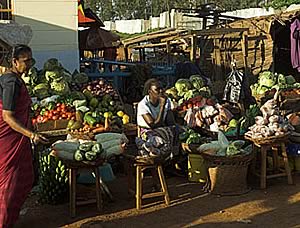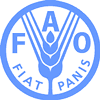 |
|||||||||
|
|||||||||||||||||||
|
|
International Prices of Agricultural Commodities Drop International prices of key food staples have dropped during the first five months of 2010 according to the latest edition of FAO's biannual Food Outlook report, released today.
The FAO Food Price Index averaged 164 points in May 2010, down from 174 points in January and substantially less than its peak of 214 in the spring of 2008, the report notes. A fall in international prices of cereals and sugar were among the main drivers behind this decline. Sugar prices have tumbled by half from their peak at the beginning of the year under prospects of significant production increases. But, the agency noted, this still means the cost of the typical food commodity basket around the world today is some 69 percent higher than in 2002-04. Most indicators point to increasing world supplies, a leading factor behind the sharp declines in international prices of major food staples this year, according to the report. "The 2008-2009 food prices boom spurred plantings and production of many crops, which has resulted in a recovery in inventories and boosting stocks-to-use ratios, a tendency likely to prevail also in 2010/11", it said. First forecasts for the global cereal market in the new season 2010/11 Today's Food Outlook provides FAO's first forecasts for cereal trade, stocks and utilization in the coming 2010/11 season. Early indications, according to the report, point towards another comfortable season, with world production in 2010 likely to match the record achieved in 2008, and global cereal inventories increasing for the third consecutive season. Importantly, the growth in production may not be confined to exporters only, as many importing countries are also expected to harvest bumper crops. Price drops mask increase in food import bills Despite price decreases, the global cost of imported foodstuffs is set to reach $921 billion in 2010, some US$100 billion -- or 11 percent more than in 2009 -- but still short of the record mark of $1 trillion set in 2008, when the food price crisis was at its peak. Much of the anticipated increase will be fuelled by higher expenditures on non-cereal products, which could rise by as much as 17 percent, to $650 billion, or around two-thirds of global food import expenditures, FAO reported. Dairy products, vegetable oils and sugar are among the foodstuffs expected to drive bills higher, through a combination of higher import volumes and prices. Expenditures on these imported commodities are forecast to surpass or near the record levels witnessed in 2008. Rising freight costs are another factor spurring food import bills, Food Outlook notes. Indicators of freight rate movements are running around 75 percent higher so far this year compared to 2009. As a result, the cost of purchasing food on the international market place for the most economically vulnerable groups -- Least Developed Countries (LDCs) and Low Income Food Deficit Countries (LIFDCs) -- is set to rise on the order of 10 and 14 percent, respectively, from last year. Sugar and cereal prices down, oilseeds and dairy hold steady, meat and fish up Sugar prices have plummeted by half from their peak at the beginning of the year -- they reached a 30-year high average of $583/tonne in January -- under prospects of significant production increases. The drop for cereals has been more modest, around 10 percent, but the expectation of another good season ahead could put further downward pressure on prices. Oilseed prices have so far resisted a major downturn, as demand remains strong and supply somewhat tighter than in the case of cereals. However, early indications suggest that oilseed prices may decline in the coming months as supply responds to high prices ease the current tightness. In contrast, prices in the meat sector have risen sharply, mostly due to declines in production while consumption is increasing. The fish sector is benefiting from some revival in demand, but, especially, of limitations on supplies. The market for Atlantic salmon remains particularly tight because of unfavourable supply developments in Chile resulting from disease outbreaks in that country's aquaculture sector. Poor prospects for milk production in important dairy exporting countries, against a backdrop of brisk import demand, are underpinning firm international dairy prices, the report added.
|
||||||||||||||||||

|
|
||||||||||||||||||
| home | agri-services | pedigree
pen | news | dairy | beef | machinery BPS | property | organisations | site map |
|||||||||||||||||||



